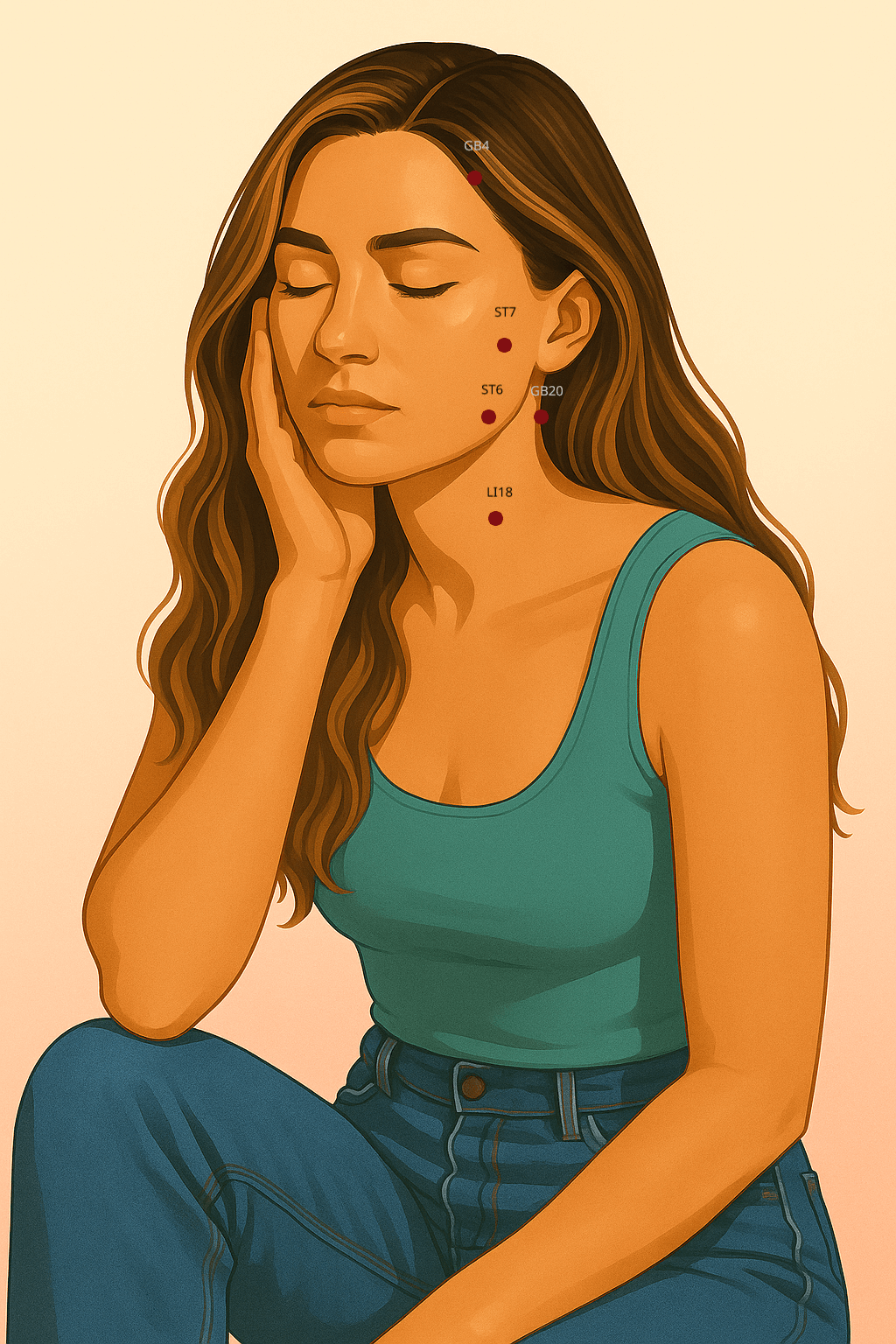Discover The Magic 6 Acupressure Points For TMJ & Jaw Pain Relief
🧭 What You’ll Learn
Discover simple, effective ways to ease jaw tension and understand what’s really happening beneath the surface. In this guide, you’ll learn:
Why TMJ pain spreads to your temples, neck, or ears
How stress and habit quietly drive clenching and jaw tightness
The Magic 6 acupressure points that help your jaw, neck, and head unwind
Step-by-step techniques for using each point safely at home
When acupressure is enough — and when acupuncture goes deeper
Take a few mindful minutes with these points and see how much lighter your jaw can feel.
Ever noticed your jaw tightening when life gets stressful? Maybe it clicks when you chew, aches after a long day, or refuses to open quite as wide as it used to. That small hinge just below your ear — your temporomandibular joint (TMJ) — is one of the body’s most complex and overworked areas.
When tension builds here, it rarely stays put. TMJ pain can radiate into the temples, neck, and even ears, leaving you with headaches, stiffness, or that constant background ache that’s hard to ignore. It’s no wonder so many people go searching for pressure points to finally relax their jaw.
These acupressure points come from the same medical system as acupuncture — techniques that influence muscle tone, blood flow, and local nerve sensitivity. Instead of needles, you’ll use gentle self-massage to help interrupt the feedback loop between muscle tension and pain.
While there’s no direct research on acupressure for TMJ pain, studies on related acupuncture techniques suggest similar mechanisms may help reduce muscle tension and ease facial or jaw discomfort. It’s not a guaranteed fix, but it offers a simple, low-risk way to reconnect with your body — and a glimpse into how professional acupuncture can go even deeper.
In this guide, we’ll explore the most useful acupressure points for TMJ-related tension, how to find them, and how to use them safely. You’ll also learn when at-home care is enough — and when it’s time to consider professional treatment.
🟧 What Exactly Is TMJ Pain (and Why It Feels Everywhere)?
Your temporomandibular joints (TMJs) are the small hinges just below your ears that let you talk, chew, yawn, and even laugh. They connect your jawbone (mandible) to your skull — and like any joint that moves constantly, they rely on balanced muscles and smooth coordination to stay comfortable.
When that balance is thrown off, problems begin. The term Temporomandibular Disorder (TMD) covers a range of issues that can affect the muscles, the joint itself, or both.
For most people, the pain doesn’t come from damage inside the joint — it comes from muscular overload. Think of it as your jaw’s version of a tension headache.
Common causes include:
Clenching and grinding (bruxism): Often linked to stress or disrupted sleep.
Posture and alignment: Forward-head posture tightens the chain of muscles from the neck to the jaw.
Injury or overuse: Trauma, dental work, or excessive intense chewing can overload the system.
Common symptoms include:
Aching or tightness in the jaw or cheeks
Clicking, popping, or restricted opening
Headaches around the temples
Neck or shoulder stiffness
Ear fullness, mild ringing, or pressure
Here’s where it gets interesting — and why TMJ pain often feels like more than “just a jaw problem.”
The same nerve network that powers your jaw — the trigeminal system — shares communication pathways in the brainstem with the upper cervical nerves that supply the neck and back of the head. When this system becomes irritated, sensitivity can spread to nearby regions. That’s why tight jaw muscles can spark temple headaches, ear discomfort, or neck tension.
Over time, these overlapping nerve circuits can become sensitised, meaning the whole area stays on high alert. This is what makes TMJ pain feel widespread and persistent — even after the original trigger has settled.
That’s also why the most effective pressure points and acupuncture strategies don’t just focus on the jaw itself — they help calm and reset the entire jaw–neck–head network.
🟧 The Most Effective Acupuncture Points for TMJ (and How to Find Them)
TMJ pain can feel like it’s coming from everywhere — the temples, the ears, the neck — but it often starts with just a few key muscles working overtime: the masseter, temporalis, and pterygoids. When these muscles tighten, they influence neighbouring structures and set off a chain reaction of tension through the jaw, head, and upper neck.
That’s why the most effective acupressure points for TMJ aren’t limited to the jaw itself. Some target the chewing muscles directly, while others release tension through the neck and shoulders — helping calm the broader system that keeps the jaw tight.
Below are six key points commonly used in professional acupuncture, adapted here for gentle, at-home use with acupressure.
(Think of this as a way to unwind tension, not replace proper treatment.)
🔸 ST6 (Jiache – “Jawbone”)
Where it is: On the side of your jaw, midway between the corner of your mouth and your earlobe. You’ll feel the muscle bulge when you clench — that’s the masseter, your main chewing muscle.
How to work it: Use the side of your index finger and thumb to gently grasp this muscle. Pull the tissue slightly outward and hold firm but comfortable pressure for about 30–60 seconds.
What it does: Loosens the masseter, eases clenching, and softens the jawline tension that builds up from stress or bruxism.
🔸 ST7 (Xiaguan – “Below the Joint”)
Where it is: Just in front of your ear, beneath the cheekbone (zygomatic arch), over the lateral pterygoid muscle. To work this spot, you will need to approach it from inside your mouth.
How to work it: Use the index finger of your opposite hand (e.g., left finger for right side). Gently slide your finger along your top teeth (inside your mouth!) toward the back of your teeth until you find soft tissue between the upper and lower jawbones. With your fingernail facing your teeth, press backward, slightly outward, and upward using the fleshy pad of your finger. Hold for 30–60 seconds.
What it does: Helps release deep pterygoid tension that often causes stiffness, clicking, or a feeling your jaw doesn’t quite “track” smoothly.
💡 Note: This point sits near the joint capsule, so always aim for comfort, not force.
🔸 GB4 (Hanyan – “Jawline Temple”)
Where it is: Just within the hairline, above and slightly forward from the ear. This lies over the temporalis muscle, which tightens with clenching and chewing.
How to work it: Turn your arms back (thumbs down) and use your fingertips — index, middle, and ring — to press gently in small circles just inside the hairline. Move the skin and muscle together for 30–60 seconds.
What it does: Relieves tension in the temporalis, easing temple headaches and jaw tightness that radiates upward.
🔸 LI18 (Futu – “Support the Prominence”)
Where it is: Along the sternocleidomastoid (SCM) — the ropey muscle running from behind your ear to your collarbone. Near the lower third, this point links with the cervical plexus, which influences neck–jaw coordination.
How to work it: Lie back with a pillow beneath your shoulder blades so your head tilts slightly back. Gently grasp the lower half of the SCM with your thumb and fingers, pulling it slightly outward and down. At the same time, turn your head gently toward the same side to feel a mild stretch. Hold for 20–40 seconds.
What it does: Reduces neck tension and postural strain that contribute to jaw clenching.
💡 Tip: This point is especially helpful if your TMJ pain travels into your neck or shoulders.
🔸 GB20 (Fengchi – “Wind Pool”)
Where it is: At the base of your skull, in the hollows beside the thick neck muscles (trapezius and semispinalis). This area connects with the suboccipital nerves, which often trigger headaches and neck tension from jaw dysfunction.
How to work it: Interlace your fingers behind your head, thumbs pointing downward. Find the soft hollows at the base of your skull. Keep one thumb in place and gently press your forehead toward that thumb — tipping your head slightly back into the pressure. Hold 20–30 seconds per side.
What it does: Relieves suboccipital tension, promotes neck mobility, and can reduce headaches tied to jaw tightness.
🔸 LI4 (Hegu – “Hand Valley”)
Where it is: In the web between your thumb and index finger — at the peak of the muscle mound when you pinch them together.
How to work it: Use the side of your opposite index finger and thumb to grasp the spot from both sides. Apply steady pressure for 30–60 seconds while breathing deeply.
What it does: Calms facial and jaw tension through trigeminal and autonomic pathways. Often used for headaches, tooth pain, and jaw tightness.
🟧 How to Get the Most From These Points
Work on three or four points at a time, not the whole set.
Use gentle, sustained massage — you’re coaxing the muscles to soften, not forcing them.
Breathe slowly and relax your jaw while working each point.
If pressing causes sharp pain, stop and have the area assessed by a practitioner.
👉 These techniques are a mindful first step — they help you explore where tension lives. But deeper muscles (like the lateral pterygoid) often need professional acupuncture to release safely and fully.
🟧 How Acupuncturists Actually Use These Points (and Why It Works Better Professionally)
If you’ve ever pressed one of these points and felt your jaw loosen a little, you’ve already experienced part of what acupuncture does — just on a smaller scale.
Acupuncturists use the same locations you’ve just learned, but with far greater precision and depth. Instead of surface pressure, fine needles reach into the muscle fibres, connective tissue, and small sensory nerves that influence how your jaw and neck hold tension.
In professional care, these points aren’t used in isolation. Your acupuncturist will combine local points — like ST6 and ST7 to release the masseter and pterygoid muscles — with adjacent and distal points such as GB20, LI18, and LI4 that calm the nervous system and help the jaw “reset.”
Depending on your presentation, treatment may also include:
Electro-acupuncture: a gentle microcurrent between points that enhances neuromuscular release.
Moxibustion: a soothing heat therapy to ease stiffness and improve local circulation.
While acupressure offers a helpful introduction, acupuncture works on a deeper level. The difference isn’t only physical — it’s neurological. Acupuncture activates pain-regulating pathways in the brain, balances local blood flow, and helps desensitise overactive nerves that keep feeding the tension loop.
💡 Think of acupressure as maintenance — and acupuncture as the reset.
🟧 What the Research Says About Acupuncture for TMJ
Now that you know which points are used in treatment, you might be wondering whether acupuncture is actually worth it.
When it comes to TMJ pain, the evidence keeps getting stronger — particularly for the muscular type (myofascial TMD), which is by far the most common.
Across multiple systematic reviews and meta-analyses published between 2017 and 2025, researchers have found that acupuncture consistently helps people with TMJ pain feel better. The studies aren’t perfect — most are small and vary in design — but the pattern is clear: less pain, better jaw movement, and very few side effects.
Keep in mind that these numbers represent averages; individual results naturally vary (for better and worse).
📊 What the Numbers Show
Pain relief: On average, acupuncture reduced jaw pain by 20–26 mm on a 100 mm pain scale compared with sham (placebo) acupuncture.
→ In plain language: that’s roughly a quarter less pain after treatment.Improved movement: Participants treated with acupuncture gained about 4 mm of extra mouth opening (Maximum Mouth Opening, or MMO) compared with inactive controls.
→ That small change can mean the difference between chewing comfortably and feeling “stuck.”Comparable to standard care: When compared with splints or physiotherapy, acupuncture generally performed about the same — meaning it’s a credible, evidence-based option alongside conventional treatment.
Add-on benefit: When acupuncture was combined with physiotherapy or splints, outcomes improved even more.
→ On average, people reported about one point less pain (on a 0–10 scale) than with standard care alone.Safety: Side effects were rare and mild — usually minor soreness or a small bruise. No serious adverse events were reported across large reviews.
🔸 Summary
Acupuncture isn’t a miracle cure, but it reliably produces measurable improvements in jaw pain and movement — especially for muscular-type TMJ disorders.
That’s why more acupuncturists, physiotherapists, and even some dentists now include it as part of integrated, multidisciplinary care for TMJ pain.
🟧 When to Try It Yourself — and When to See a Professional
If your jaw only feels tight after a stressful day, or you catch yourself clenching when focused, gentle acupressure can be a great place to start. It helps you tune in to your body, break the habit of tension, and remind those overworked jaw muscles to rest.
But sometimes, jaw pain runs deeper than what self-massage can reach.
Here’s a simple guide to help you decide what’s best for you:
When At-Home Care Is Enough
Your symptoms are mild — tightness, clicking, or light discomfort that comes and goes.
You notice the problem mainly during stress or concentration.
You get some relief from massage, stretching, or relaxation.
You’re curious about learning how the jaw muscles and pressure points connect.
In these cases, acupressure can help you develop awareness and maintain comfort between professional sessions.
When to Consider Professional Help
The pain is persistent or affects daily activities like eating or speaking.
You wake up with sore or stiff jaw muscles most mornings.
You experience headaches, ear fullness, or ringing that don’t settle.
Think of acupressure as maintenance — and acupuncture as the reset. Both can play a role, depending on where you’re at and what your jaw needs.
🟧 The Bottom Line
Your jaw doesn’t clench in isolation — it’s part of a much bigger story about how your body responds to stress, posture, and daily strain.
Exploring acupressure points is a simple, low-risk way to start loosening that tension and tuning into what your body’s been holding.
But when jaw tightness keeps coming back, or pain spreads into your head, neck, or ears, that’s a sign your body needs deeper help.
That’s where acupuncture steps in — targeting the same points more precisely to calm nerves, release muscles, and restore balance in a way fingertips simply can’t reach.
🟧 Author
Adam Hjort is a Registered Acupuncturist and member of Australian Acupuncture & Chinese Medicine Association (AACMA). He has been practicing since 2010 and maintains a clinic dedicated to the treatment of pain, inflammation, stress, and other health conditions, located in Ashmore, Gold Coast.



